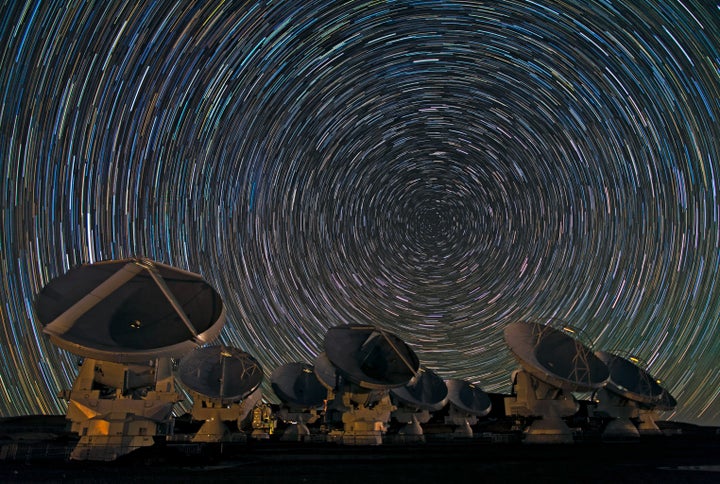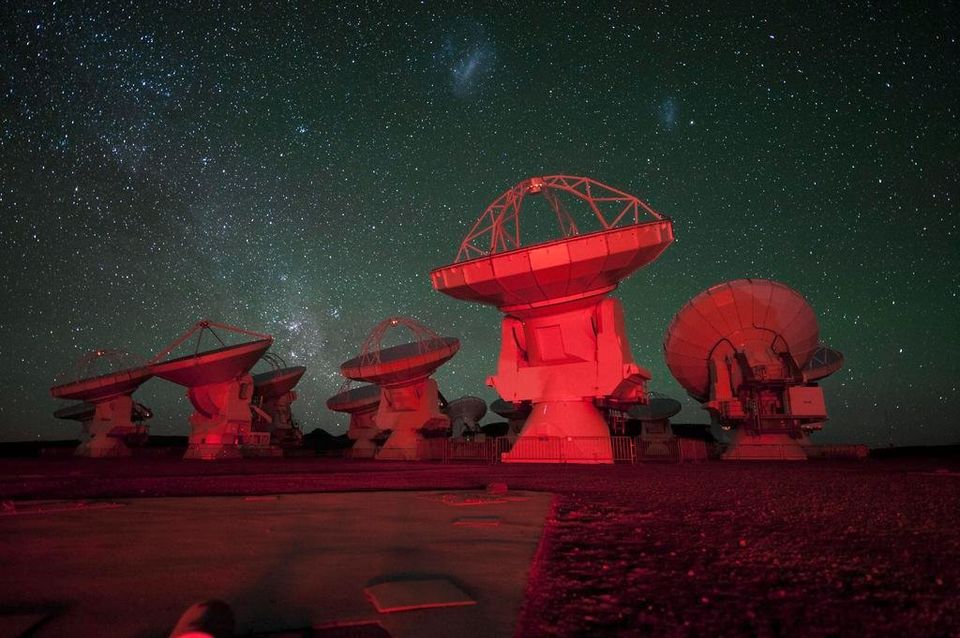
Astronomers expect the Atacama Large Millimeter/Submillimeter Array (ALMA), the huge radio telescope that was inaugurated in March, to provide answers to some specific questions. How did the first stars form? Why are some huge and others small? What about the earliest galaxies? And why do planets form in some stellar environments and not others?
But astronomy buffs have another set of questions -- about ALMA itself. After all, the $1.3-billion radio telescope –- considered by some to be the finest earth-based observatory -– is unlike any other telescope. People want to know about ALMA's remote location in Chile, its massive antennas, and just how these dishes work to peer into deepest space.
For answers to these and other questions, HuffPost Science reached out to ALMA's former deputy project scientist Dr. Alison B. Peck.
ALMA is situated on a high plateau in Chile's Atacama Desert. What makes that location so special?
Many sites were investigated for ALMA, but the clear winner was the Chajnator Plateau in northern Chile. It offers the perfect combination of dryness, altitude, and expanse.
The main consideration in choosing a site for a submillimeter telescope like ALMA is water. We don't have to worry about light pollution -- we can even observe in the daytime. But water in the atmosphere absorbs the faint emissions from cosmological distances. The plateau’s 5,000-meter (16,000-foot) elevation puts us above a large fraction of the atmosphere. And the Atacama Desert is a remarkably dry environment, meaning that what atmosphere does remain above us contains very little water vapor.
In addition, we needed a large, flat area to be able to move around the antennas that make up ALMA. So that meant we needed a wide, flat area, like the plateau. ALMA's location ensures that we'll have the best possible sensitivity even to faint and very distant objects.
When completed, ALMA will have 66 dish antennas. Why not more -- or fewer?
Determining the ideal number of antennas for an array like ALMA is complicated business. There are obviously practical limits to how many antennas you can build, transport and keep in working order in the harsh environment of the high Atacama Desert.
Several people spent a few years with computer simulations determining what the optimal number of antennas would be, and even more important, where to place them on the ground in order to ensure the maximum coverage of the "mirror" in the shortest amount of time.
What makes ALMA's dish antennas so special?
These antennas need to be extremely robust because they are always outside in the weather and not inside a protective dome. While there isn’t much rain or snow at the site, there are strong winds (up to 70 miles an hour), very strong ultraviolet radition, and an extreme range of temperatures. Less robust antennas wouldn’t work. These are rigid enough to maintain a surface accuracy (the smoothness of the dish) better than the width of a human hair for months in order to reflect the submillimeter wavelength light into the receiver. They are able to point at a position on the sky with an accuracy better than 0.5 arcseconds (less than the width of a dime seen from a distance of 1.5 miles). The antennas can track this position all the way across the sky, in unison, to make an image.
Why are there two sizes of antennas? Why 12 meters -- as opposed to bigger or smaller? Why 7 meters?
The size of the antennas was determined by the practical limitations of constructing antennas that can be assembled and maintained at the site. A large-diameter antenna collects more light but gives a smaller field of view. This is bad for seeing star-forming clouds and other very big objects. We wanted to have a large-diameter antenna to have good sensitivity to faint sources, but we also wanted to be able to see big things. So we achieved these goals by having two sizes of antennas.
Why were the antennas designed to be moved from location to location at the site?
Having antennas that can be moved is a bit like having a zoom lens on a camera. Keep the antennas close together, and most of your "mirror" is filled in so you don't lose much light. Move the antennas far apart, and it's like zooming in on that part of the sky -- you can see tremendous detail in a very small field of view.
Where you want the antennas to be depends on the kind of observations you’re making. If you want a detailed look at something small, like a star system that might be forming a protoplanetary disk, then you want the antennas far apart. But to measure how much gas is in a whole galaxy to see how many stars it might form in future, you need a large field of view –- so you keep the antennas close together.
Just how far is ALMA able to see? How does that compare to other telescopes' abilities, including Hubble?
That's not really the right question. A better question is how much ALMA can learn from very distant objects. Most large, modern telescopes can detect –- albeit faintly -- light that was emitted close to the beginning of the universe 11-12 billion years ago.
But Hubble, while obviously still a forefront instrument and not subject to the difficulties associated with having to observe through Earth's atmosphere, has a relatively small mirror. But it simply doesn't have the angular resolution of larger mirrors -- no zoom.
When ALMA is completed, the resolution at the highest frequencies will be almost 100 times that of Hubble. So while Hubble can see as far back into space and time, it won't gather as much information from the sources there. More important, Hubble is observing optical light, which traces different physical processes than ALMA. While Hubble is detecting higher-energy regions in space, where stars or quasars have already formed, ALMA can detect cold gas and dust before they light up at optical wavelengths. This gives us a better means of identifying the processes that cause stars and galaxies to be born.
How long will ALMA be operational? Any idea when it will be retired?
ALMA will be operational for at least 30 years. Scientists and engineers are working on a plan to make upgrades to the telescope over this period. These can be to the hardware, software, infrastructure -- there are all kinds of ideas. So even though 30 years is a long time, ALMA will never get old.

